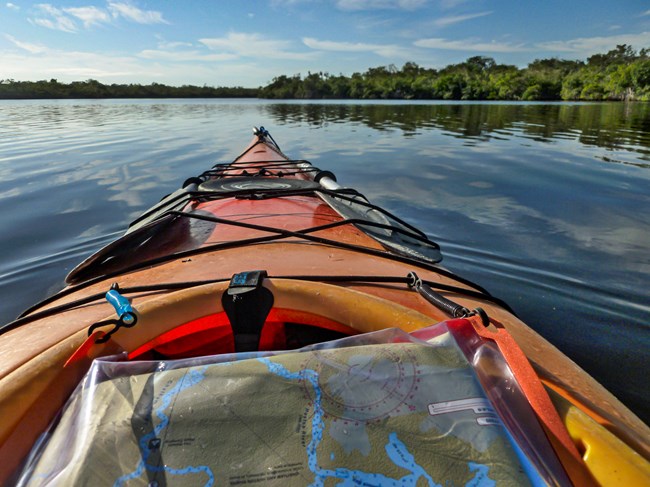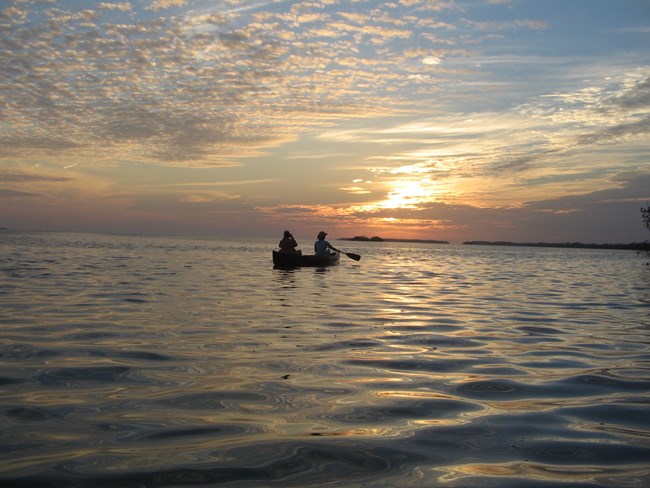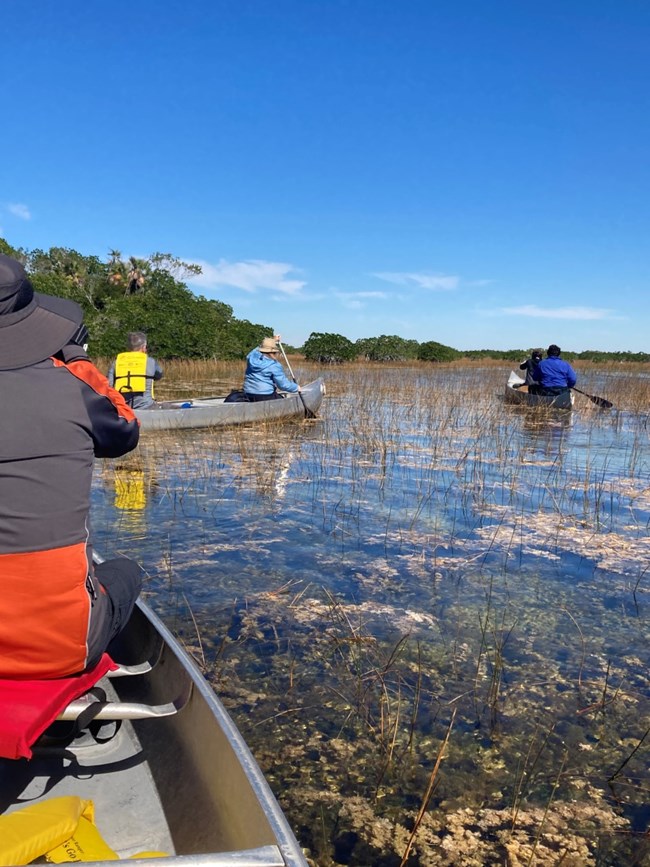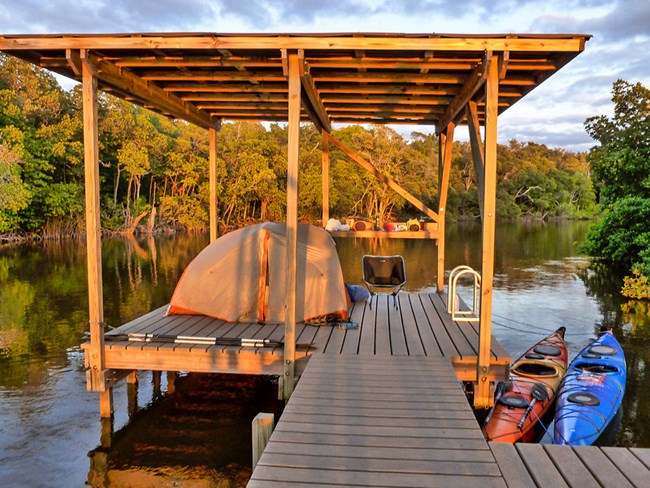Paddling through the EvergladesEverglades National Park offers many paddling opportunities to explore the natural beauty of this area through freshwater marsh, mangrove forests, the 10,000 Islands, and the open waters of Florida Bay. Plan AheadCanoe and kayak trips range from a few hours to several days depending on length and complexity of the trail. You can bring your own canoe or kayak and launch from several locations around the park or rent a kayak or canoe in the park. Alternatively, you could hire a permitted guide who will outfit your trip and lead your adventure. A list of permitted guides can be found at this link. Canoe and Kayak Rental InformationGulf Coast Canoe and Kayak Rentals
Flamingo Canoe and Kayak Rentals

NPS / Jane Gamble Gulf Coast Paddling TrailsThis area of the park is on Florida's west coast, accessible from Everglades City. The public, non-motorized launch on the Gulf Coast Visitor Center grounds is currently closed for construction, but private boat ramps are available in Everglades City and Chokoloskee for a fee. Alternate launch sites include the Rod & Gun Club, Outdoor Resorts of Chokoloskee, and Chokoloskee Island Park and Marina.
Below is a list of designated paddling trails in the Gulf Coast area. 6.5 miles, accessible from Everglades City and Chokoloskee. Trip durations may vary if you walk the 1-mile hiking trail on Sandfly Island or if strong winds or unfavorable tides are present. If you decide to stop at Sandfly Island, please use the beach area next to the dock, as the dock is currently in disrepair. A portable toilet is available near the dock. Tide charts are available online.
From the Turner River canoe launch on US 41: 8.5 miles to Chokoloskee. The Turner River may be impassable if water levels are too high or too low. Check water levels at the Nathaniel P. Reed Visitor Center. Alligators are in the area. Keep a safe distance and give them the right of way. Visitors can launch from Everglades City, Chokoloskee, or the Turner River Canoe Launch in Big Cypress National Preserve.
Attention: Halfway Creek is not completely passable at this time. You can put in and paddle from Sea Grape Drive in Big Cypress south towards the HC 1 marker. To complete the through-trip, paddlers must head west once they encounter the HC3 / L 15 marker, and continue following the L markers. Once you travel across the “lake,” look for the L 14 marker. The numbers will continue to descend and take you to L 5 or L 6. From there, head west and you will come out by Everglades City. From the L 3 marker up to the L 1 marker is impassable.
The Halfway Creek-Left Hand Turner-Turner River loop is also not accessible at this time. The Halfway Creek and Loop Trails are accessible from Everglades City, Chokoloskee, or the Nathaniel P. Reed Visitor Center on Sea Grape Drive off of US 41. Depending on your route, the trail is 7.3-11 miles long. Sections of the trail may be impassable at low tide. Contact the Nathaniel P. Reed Visitor Center at (239) 695-1168 for questions about water level. From Everglades City, the Halfway Creek-Left Hand Turner-Turner River loop is approximately 12-14 miles. Allow 4-10 hours for these trails. 
NPS Photo Flamingo Paddling TrailsThese trails range from beginner to advanced and can be accessed from launch areas in the Flamingo marina or along the main park road as you approach Flamingo. Flamingo is located 38 miles from the park entrance station in Homestead. Water levels here can fluctuate greatly so approach the trail with caution. If shallows are encountered, turn around, do not risk getting stuck. Periphyton, a community of sponge-like organisms, can restrict the ability to paddle. If difficulty is encountered, do not proceed. If you are unsure of the route, do not guess, go back the way you came. Do not overestimate your abilities.
5 mile loop; 3.5 mile shortcut, trailhead accessible from the main park road. This scenic trail passes through shallow grassy marsh with scattered mangrove islands. Watch for alligators, wading birds, and an occasional endangered snail kite. The trail is marked with numbered white poles. A more detailed trail map is also available at visitor centers. Trail may be impassable due to low water levels near the end of the dry season, ask a Park Ranger for current conditions. Motors prohibited. 1.9 mile loop, trailhead accessible from the main park road. Winding through a maze of shady mangrove-lined creeks and small ponds, the sharp turns and narrow passageways require good maneuvering skills. Enjoy a “crash” course. Check for low water levels during the dry season. A calm trail on a windy day. Motors prohibited.
Distance varies depending on destination, trailhead accessible from the main park road. “Hell to get into and Hell to get out of,” or so the old timers claimed. This sheltered route weaves through mangrove creeks and ponds to a series of small bays beyond the Lard Can wilderness campsite. The trail is marked with more than 160 poles. A more detailed trail map is also available at visitor centers. Motors are prohibited from the trailhead to Lard Can. A wilderness permit is required for overnight camping.
Distance varies, accessible from Flamingo marina. Opportunities for fun abound! Watch mullet jump and birds feed (particularly in Snake Bight), do some fishing, or just enjoy the scenic bay. Explore Bradley Key, the only nearby key open to landing (open during daylight hours only). The open waters of Florida Bay are relatively mosquito-free, even in the summer. Not recommended on windy days due to open, rough waters. Route to Snake Bight may be impassable during extremely low tides.
(Impassable) - 11.5 miles one-way to Cape Sable, trailhead accessible from Bear Lake Road or the Flamingo marina. Impassable from Bear Lake to Cape Sable as of September 2010. Check at the Flamingo Visitor Center for current conditions.
(Impassable) - 7.5 miles round trip from Coot Bay Pond, route may start at Coot Bay Pond or Bear Lake trailhead. Venture inland through the mangroves on this trail connecting the Buttonwood Canal, Coot Bay, Mud Lake, and the Bear Lake Canal. Birding is often good at Mud Lake. There is a 250 yard portage between the Bear Lake and Buttonwood Canals. Motors are prohibited on Mud Lake, Bear Lake, and Bear Lake Canal. Check trail conditions first as Bear Lake Canal is too shallow during parts of the year.
8.1 miles one-way to Alligator Creek, trailhead accessible from the main park road. Paddle through a series of large open lakes connected by narrow creeks lined with mangroves. Look for alligators and crocodiles. West Lake is closed to vessels with motors greater than 6 horsepower. Motors are prohibited from the east end of West Lake through Alligator Creek. Not recommended on windy days due to open, rough waters. A wilderness permit is required for overnight camping.

Florida National Parks Association Everglades Institute Nine Mile Pond ToursThe Everglades Institute offers guided paddling tours of Nine Mile Pond when water levels permit. Canoes and paddling equipment will be supplied to all guests.

NPS / Jane Gamble Overnight Trips in the WildernessFor multi-day trips, wilderness camping in Florida Bay and the 10,000 Islands or along the 99-mile Wilderness Waterway require careful planning, but are well worth the experience. |
Last updated: March 20, 2025
